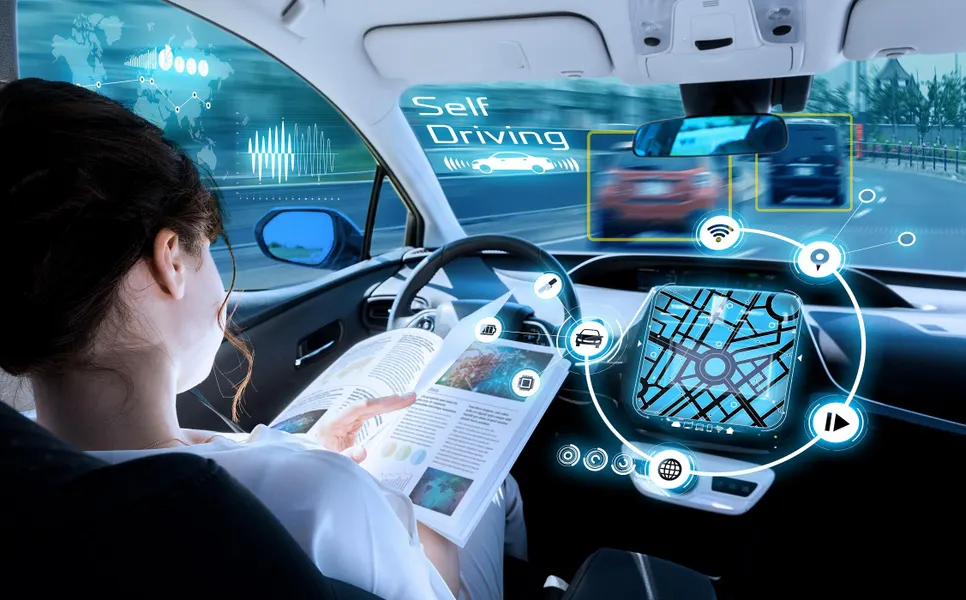|
Getting your Trinity Audio player ready...
|
The dawn of autonomous vehicles represents a paradigm shift in transportation, offering the potential to revolutionize mobility, enhance safety, and benefit the way we travel. In this comprehensive guide, we’ll delve into the world of autonomous vehicles, uncovering the technology behind them, exploring their benefits and challenges, and envisioning the future of mobility.
Understanding Autonomous Vehicles
What Are Autonomous Vehicles?
- Autonomous vehicles, also known as self-driving or driverless cars, are vehicles equipped with advanced sensors, cameras, and artificial intelligence (AI) systems that enable them to navigate and operate without human intervention.
Levels of Autonomy:
- The Society of Automotive Engineers (SAE) defines six levels of autonomy, ranging from Level 0 (no automation) to Level 5 (full automation), where the vehicle can perform all driving tasks under all conditions without human intervention.
The Technology Behind Autonomous Vehicles
Sensors and Perception Systems:
- Autonomous vehicles rely on a combination of sensors, including LiDAR, radar, cameras, and ultrasonic sensors, to perceive and interpret their surroundings. These sensors provide real-time data about obstacles, road conditions, and traffic patterns.
Artificial Intelligence and Machine Learning:
- AI algorithms process the sensor data and make real-time decisions about navigation, trajectory planning, and vehicle control. Machine learning techniques enable autonomous vehicles to learn from experience and improve their driving capabilities over time.
Benefits of Autonomous Vehicles
Enhanced Safety:
- Autonomous vehicles have the potential to significantly reduce traffic accidents and fatalities by eliminating human error, which is a leading cause of road accidents. Advanced safety features, such as collision avoidance systems and adaptive cruise control, enhance overall road safety.

Pro Tip for Autonomous Vehicle Users
While autonomous vehicles offer convenience and potential safety benefits, it’s essential to remain informed and vigilant when using them. Here’s a pro tip: Stay educated about the capabilities and limitations of autonomous technology. Understand the level of autonomy of your vehicle and familiarize yourself with its features, including emergency protocols and manual override options.
Improved Mobility and Accessibility:
- Autonomous vehicles can provide mobility solutions for individuals who are unable to drive due to age, disability, or other factors. They offer greater accessibility and independence, enabling more people to access transportation options and participate in social and economic activities.
Challenges and Considerations
Regulatory and Legal Challenges:
- The widespread adoption of autonomous vehicles raises complex regulatory and legal questions related to liability, insurance, privacy, and ethical considerations. Governments and policymakers are grappling with the need to establish clear guidelines and standards for the deployment of autonomous vehicles on public roads.
Technical Limitations and Reliability:
- Despite rapid advancements in technology, autonomous vehicles still face technical limitations and reliability concerns, particularly in complex driving scenarios, adverse weather conditions, and unpredictable environments. Ensuring the safety and reliability of autonomous systems remains a key challenge for developers and manufacturers.
The Future of Mobility
Urban Mobility Solutions:
- Autonomous vehicles have the potential to transform urban mobility, offering on-demand transportation services, reducing traffic congestion, and optimizing transportation networks. Shared autonomous fleets and mobility-as-a-service (MaaS) platforms could revolutionize the way people move within cities.
Environmental Sustainability:
- By optimizing driving patterns, reducing fuel consumption, and promoting electric and alternative fuel vehicles, autonomous vehicles can contribute to environmental sustainability and mitigate the impact of transportation on climate change. They offer opportunities to create more efficient and eco-friendly transportation systems.
Conclusion: A New Era of Transportation
As autonomous vehicles continue to evolve and mature, they hold the promise of a safer, more efficient, and more accessible transportation future. While there are challenges to overcome and considerations to address, the transformative potential of autonomous technology is undeniable. By embracing innovation, collaboration, and responsible deployment, we can navigate the future of mobility and unlock the full benefits of autonomous vehicles for society.
FAQS
Are autonomous vehicles already on the roads?
Yes, autonomous vehicles are undergoing testing and deployment in various locations around the world. While fully autonomous vehicles are not yet available for widespread consumer use, companies are testing prototypes and conducting pilot programs to assess their performance and safety.
How do autonomous vehicles handle complex driving scenarios?
Autonomous vehicles use a combination of sensors, cameras, and artificial intelligence (AI) algorithms to perceive and interpret their surroundings. They rely on detailed mapping data, predictive modeling, and advanced decision-making capabilities to navigate complex driving scenarios, such as intersections, construction zones, and adverse weather conditions.
What safety measures are in place to ensure the reliability of autonomous vehicles?
Autonomous vehicles undergo rigorous testing and validation processes to ensure their safety and reliability. This includes simulation testing, real-world driving trials, and adherence to regulatory standards and industry best practices. Additionally, autonomous vehicle developers prioritize safety features such as redundant systems, fail-safe mechanisms, and continuous monitoring of vehicle performance.
How do autonomous vehicles address ethical considerations and decision-making in critical situations?
Autonomous vehicles are programmed to prioritize safety and minimize harm in critical situations. AI algorithms are trained to analyze various factors, including traffic conditions, pedestrian behavior, and environmental cues, to make split-second decisions. Developers are also exploring ethical frameworks and guidelines to address complex moral dilemmas, such as determining the appropriate response in unavoidable collision scenarios.
Will autonomous vehicles replace traditional human-driven vehicles entirely?
While autonomous vehicles offer numerous benefits, including enhanced safety and efficiency, they are unlikely to replace traditional human-driven vehicles entirely in the foreseeable future. Instead, autonomous and human-driven vehicles are expected to coexist, with each serving specific purposes and preferences. The transition to widespread adoption of autonomous vehicles will likely be gradual and influenced by factors such as technological advancements, regulatory frameworks, and societal acceptance.
You May Find This Useful:
